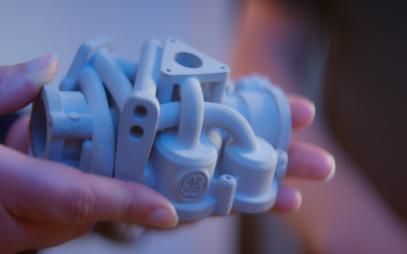From left to right: Christine Furstoss, chief technology officer, GE Additive; Daniel Simmons, Assistant Secretary, US Department of Energy - Office of Energy Efficiency and Renewable Energy; Moe Khaleel, Associate laboratory director for Energy and Environmental Sciences and Chris Schuppe, general manager, engineering, GE Additive.
Cincinnati, OH – GE Additive today announced that it has entered into a five-year cooperative research and development agreement (CRADA) with the US Department of Energy’s Oak Ridge National Laboratory (ORNL). The agreement focuses on processes, materials and software to drive industrialization and encourage the broader adoption of additive manufacturing technology.
The agreement supersedes an existing CRADA in place since 2012 between ORNL and GE Additive. ORNL purchased its first Arcam EBM system in 2009 for the US Department of Energy’s Manufacturing Demonstration Facility in Knoxville, Tennessee. Since that time, ORNL and the Arcam EBM teams have worked together to create opportunities for companies, in multiple US manufacturing sectors, to adopt electron beam melting technology (EBM).
The research objectives of CRADA with Arcam EBM focused on: improving the process reliability of EBM technology through the use of in-situ process monitoring and closed loop control, expanding the technology to new materials systems, specifically Nickel-based superalloys, and validating microstructure and properties of Titanium Ti-6Al-4V materials fabricated with increased deposition rate.
The new CRADA, which covers all GE Additive equipment, materials and engineering services capabilities, focuses on developing and implementing novel additive technologies into commercial products including:
- Building on existing research into process simulation methodologies and in-situ monitoring and quality control, on both EBM and direct metal laser melting (DMLM) systems
- Materials modeling and development
- Industrialization and commercialization of equipment and processes
“Our pioneering research with GE Additive was essential to resolving scientific challenges in advanced metals manufacturing using new electron beam methods,” said Moe Khaleel, associate laboratory director for Energy and Environmental Sciences at ORNL. “We’re excited to again push the boundaries with GE and lower the barriers for widespread adoption of more efficient, low-cost manufacturing techniques.”
“By collaborating with industry partners such as GE Additive, DOE’s Oak Ridge National Laboratory brings its multi-disciplinary expertise and capabilities to bear on real-world challenges and moves technologies into the marketplace where they will have the greatest economic impact,” said Daniel R. Simmons, Assistant Secretary for DOE’s Office of Energy Efficiency and Renewable Energy.
“We’re really looking forward to applying the collective brainpower and expertise from both organizations to addressing the challenges around industrialization, but we also have an eye on the future,” said Josh Mook, innovation leader, GE Additive.
“The next wave of additive technology is already upon us – whether that’s binder jet or rapid advances in software – so, we’re excited to see where the next five years will take us,” he added.



